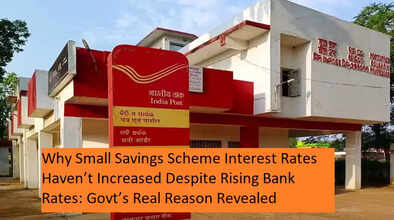Small Saving Scheme: Why did the government not increase the interest rates of small savings schemes? Know the reason

Why the Government Hasn't Raised Interest Rates on Small Savings Schemes – Here's the Real Reason
Despite rising interest rates on fixed deposits (FDs) and home loans over the past two years, the Indian government has kept the interest rates on popular small savings schemes unchanged. Public Provident Fund (PPF), National Savings Certificate (NSC), Sukanya Samriddhi Yojana, and Kisan Vikas Patra continue to offer the same returns since 2022. This has raised questions among investors about why these rates remain stagnant when banking institutions have revised theirs upwards.
The Real Reason Behind No Rate Hike
The answer lies in a decision made during the early months of the COVID-19 pandemic. In March 2020, the Reserve Bank of India (RBI) slashed the repo rate by 75 basis points to 4.40% in an effort to ease the financial burden on households and businesses during the nationwide lockdown. Following the RBI’s lead, banks reduced interest rates on savings accounts and FDs.
However, during this period, the government chose not to reduce the interest rates on small savings schemes. This was primarily to ensure that senior citizens and middle-class families who rely on these schemes for regular income were not adversely affected.
Now, even though the RBI has increased repo rates again and banks are offering higher returns, the government has still kept rates on these schemes unchanged.
Managing Fiscal Burden: A Balancing Act
According to financial experts, the key reason for maintaining status quo on interest rates is the government’s intent to keep its interest outgo under control. If interest rates on small savings schemes were raised, the government would be obligated to pay more to investors, thereby increasing its fiscal burden.
By not increasing the rates, the government is striking a delicate balance between offering reasonable returns to savers and ensuring the fiscal deficit does not widen.
This strategy also works because during periods when banks were offering lower FD rates, small savings schemes were more attractive. Now that banks have hiked their deposit rates, the appeal of government schemes remains steady due to their assured returns and sovereign backing.
Future Rate Hike Depends on Inflation and Liquidity
Officials from the Ministry of Finance have stated that any future revision in interest rates will depend largely on economic factors like inflation trends and market liquidity. If inflation rises significantly or if liquidity tightens, the government may reconsider and hike the interest rates on these schemes to remain competitive and beneficial for savers.
Current Interest Rates on Popular Small Savings Schemes (as of Q2 FY2025-26):
-
Public Provident Fund (PPF): 7.1%
-
National Savings Certificate (NSC): 6.8%
-
Sukanya Samriddhi Yojana: 7.6%
-
Senior Citizen Savings Scheme (SCSS): 7.4%
-
Post Office Monthly Income Scheme: 6.6%
-
Kisan Vikas Patra: 6.9%
Still a Safe Bet for Conservative Investors
Despite not offering the highest returns compared to some bank FDs today, these schemes remain popular, especially among the middle class, retirees, and conservative investors. Their biggest strengths lie in the government backing, assured interest payments, and exemption or partial exemption from tax under Section 80C of the Income Tax Act (in select cases like PPF and Sukanya Yojana).
In conclusion, while many expected a hike in small savings scheme rates following the RBI’s multiple repo rate increases, the government has prioritized fiscal discipline over populism. However, if economic conditions change significantly, interest rate revisions may still be on the cards.

